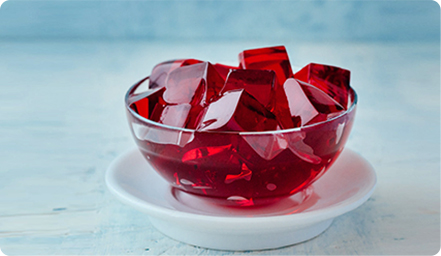-
July, 26,2025
Understanding the Role of Bloom Strength in Soft Gelatin Capsules
-
July, 25,2025
Bloom Strength and Its Impact on Hard Gelatin Capsules
-
July, 21,2025
How Gelatin Is Revolutionizing Pet Food: A Healthier Option for Dogs
-
June, 22,2025
Collagen as a Trusted Ingredient: Meeting Global Demand with Reliable Supply
Gelatin Know-How: Understanding Gelling Power and Its Role in Formulation
Gelatin is not just a functional ingredient but rather a cornerstone of formulation science in foods, pharmaceuticals, and nutraceuticals. At its core lies gelling power, a property measured by Bloom strength, which directly affects texture, product stability, and manufacturing performance.
While widely used, the understanding of gelatin's true formulation capability is generally superficial. In this comprehensive guide, FNP Gelatin walks you through the scientific principles and real-world practices that are the foundation of effective gelatin application—from correct Bloom measurement to global application trends and formulation troubleshooting.
Table of Contents
- What Is Gelling Power and Why Does It Matter?
- How Is Bloom Strength Measured (and Misunderstood)?
- Key Processing Variables That Affect Gelling Performance
- Formulating with Other Hydrocolloids: Synergy or Conflict?
- Regional Preferences in Gel Texture and Bloom Selection
- Common Gelatin Troubleshooting Guide
- Application Comparison: Gummies, Dairy, and Capsules
- Why Gelling Power Still Outperforms Alternatives
- Final Thoughts: Gelling Power as a Strategic Formulation Tool
- FAQ – Understanding Gelling Power
What Is Gelling Power and Why Does It Matter?
Gelling power refers to the ability of gelatin to form a firm three-dimensional gel network. It is quantified by the Bloom test, which is the weight (in grams) needed to push a plunger 4 mm into a standard 6.67% gelatin gel after 17 hours at 10°C.
Gelling power refers to gelatin’s ability to form a stable three-dimensional gel network. This property is quantified using the Bloom test, which measures the force (in grams) needed to depress a plunger 4 mm into a standard 6.67% gelatin gel after 17 hours at 10°C.
Typical Bloom values:
- High Bloom (220–260g): Firm, elastic texture—ideal for jellies and gummies.
- Medium Bloom (150–200g): Suitable for desserts, yogurts, and softgel capsules.
- Low Bloom (80–120g): Suitable for protein beverages and emulsions.
Want to get consistent gel quality in your production process? More in our related article: How to Bloom Gelatin – Master the Perfect Texture
Looking for a trustworthy gelatin manufacturer with stable Bloom grade control? FNP Gelatin offers consistency batch after batch.
How Is Bloom Strength Measured (and Misunderstood)?
The Bloom test is standardized, but actual results may vary depending on:
- Water purity and mineral content
- Gelatin pre-treatment (soaking and dissolving)
- Time-temperature history
- Environmental control during testing
Common misconceptions:
- "Higher Bloom = higher quality": Not true—quality depends on the intended application.
- "Bloom strength is fixed": It can fluctuate based on raw material source and processing method.
- "Viscosity = gel strength": Incorrect—viscosity affects solution behavior before setting; Bloom governs firmness post-gelation.
At FNP Gelatin, rigorous quality control ensures consistent Bloom grade specifications for both food and pharma applications.
Key Processing Variables that Affect Gelling Performance
In spite of correct Bloom value, processing conditions control ultimate gel quality:
|
Parameter |
Ideal Range |
Impact |
|
|
|
|
|
|
|
|
|
|
|
|
|
|
|
|
|
|
|
|
Optimum conditions need to be preserved to achieve consistency in large-scale production.
Formulating with Other Hydrocolloids: Synergy or Conflict?
Modern food and supplement products often include multiple hydrocolloids. While gelatin may be utilized by itself, strategic combination with other gelling agents creates tailored textures.
Common Combinations:
- Gelatin + Pectin: Jam, jelly, or reduced-sugar gummies with layered firmness and spreadability.
- Gelatin + Agar: High-temp-stable desserts or plant-based gels.
- Gelatin + Starch: Pudding and custards with enhanced creaminess.
- Gelatin + Arabic Gum or Xanthan: Functional beverages and emulsified sauces.
Careful balance is needed—some gums disrupt gelatin's network formation or alter setting temperature. In these cases, Bloom strength selection must be adjusted to maintain gel structure.
Regional Preferences in Gel Texture and Bloom Selection
Global markets show distinct preferences for gel consistency based on cultural expectations:
|
Region |
Preferred Texture |
Typical Bloom Use |
|
|
|
|
|
|
|
|
|
|
|
|
|
|
|
|
|
|
|
|
When developing a beauty drink in Korea, a gummy in Germany, or a gel dessert in Mexico, understanding regional textural expectations helps to select the right Bloom range.
Common Gelatin Troubleshooting Guide
Gelatin products can fail for numerous reasons, typically formulation or process mismatches. Diagnose and correct them as indicated below:
|
Symptom |
Possible Cause |
Fix |
|
|
|
|
|
|
|
|
|
|
|
|
|
|
|
|
|
|
|
|
Proper raw material control and process discipline are the foundations of gel stability.
Application Comparison: Gummies, Dairy, and Capsules
Different formulations demand different gel characteristics:
- Gummies: Need high Bloom gelatin for elasticity and clarity under ambient conditions.
- Dairy Products: Use medium Bloom to avoid syneresis while delivering spoonable textures.
- Softgel Capsules: Require precise Bloom for wall integrity and consistent disintegration rates.
Why Gelling Power Still Outperforms Alternatives
Though alternatives like pectin, carrageenan, or agar exist, gelatin remains irreplaceable in many use cases due to:
- Natural mouth-melting behavior
- Excellent elasticity and chewiness
- Efficient film-forming and emulsifying ability
- Superior flavor release
These advantages make gelatin the preferred choice in confections, capsules, marshmallows, and functional foods.
Final Thoughts: Gelling Power as a Strategic Formulation Tool
For formulators, food technologists, and procurement managers, gelling power is not just a technical metric—it’s a product success factor. Whether creating innovative gummies or reliable pharma delivery systems, understanding and controlling Bloom strength is essential.
At FNP Gelatin, we go beyond simply supplying edible gelatin. As a trusted gelatin manufacturer, we help brands choose the right Bloom grade to match their desired texture, process, and market expectations—supporting quality and consistency from lab to line.
FAQ – Understanding Gelling Power
Q1: What is the optimum application of 250 Bloom gelatin?
Ideal for firm, elastic textures like gummies, jellies, or protein bars.
Q2: Can low Bloom gelatin be used in candies?
No. It forms soft, sticky gels that are deformed easily.
Q3: Is stronger gel higher viscosity?
Not necessarily. Viscosity controls flow of solutions; Bloom controls firmness of set.
Q4: How do I prevent soft or weak gels?
Use the right Bloom grade, correct pH and concentration, and don't overheat.
Q5: Where do I find Bloom-specific gelatin?
You can buy food-grade and pharma-grade gelatin by Bloom range from FNP Gelatin, a global supplier with quality assurance and international logistics.
Image source
https://www.youtube.com/watch?v=iV5uxUGhb74
Phone: +86-577-88105990
Mobile: +86-138 5886 1938
Official Website: www.fnp-gelatin.com
Email: sales@funingpu.com
Address: No. 1-10 Wenpu Road, Yacheng Town, Xiapu County, Ningde City, Fujian Province




